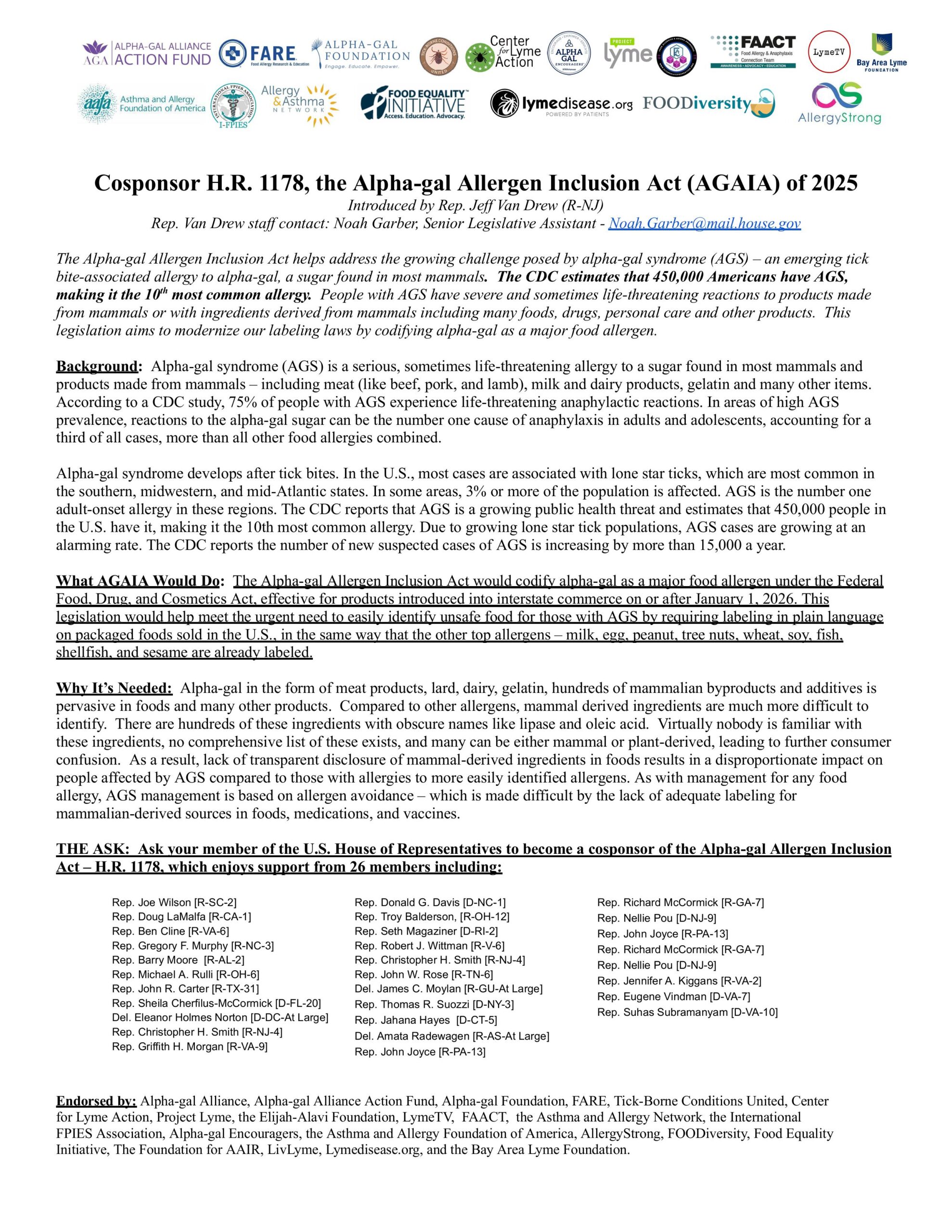The Alpha-gal Allergen Inclusion Act
ACT NOW!

Take Action on the Alpha-gal Allergen Inclusion Act!
Please urge your member of the US House of Representatives to cosponsor the Alpha-gal Allergen Inclusion Act. The below button will take you to a form that makes it easy.
This bipartisan bill would require the FDA to add alpha-gal to the list of major food allergens.
Right now, there is no requirement to list alpha-gal on food labels, and people with alpha-gal syndrome have to guess whether a product contains the allergen that could harm them. If the bill passes, disclosing alpha-gal on the label of most packaged foods will be required.
What Next?
You will probably get a response from your Congressional representative. It will likely be an AI-generated automatic response. You can follow up by calling and emailing your Representative’s office and speaking to the staff member who handles health issues.
Call the staff member who handles health issues for your Representative about the bill
Step #1
If you don’t know the name of your Representative, find it by entering your address into this tool.
Step #2
Do one of the following:
Option #1: Call the U.S. House Switchboard Operator at (202) 224-3121. Ask to be connected you to your Representative‘s office. Ask the person who answers the phone at your Representative’s office to connect you to the staff member who handles health issues OR
Option #2: Find the name and number of the staffer who handles health issues here.
Download script for calls to Congressional health staffers
Email the staff member who handles health issues for your Representative about the bill
Find the name and email of the staffer who covers health issues here. Send them a follow up email with:
-
-
- A copy of the below bill summary attached and
- A PDF of this factsheet attached or with a JPG of this factsheet embedded in your message.
- Your personal message about why the bill is important to you and your family.
-
HR 1178
The Alpha-gal Allergen Inclusion Act
(formerly HR 9382)
Bill Summary
Bill Text
Read the text of the bill and find the latest information about HR 1178, the Alpha-gal Allergen Inclusion Act here.
Why We Need the Alpha-gal Allergen Inclusion Act
Prevalence of AGS
- According to CDC estimates, alpha-gal syndrome (AGS) affects up to 450,000 people in the U.S., making it the 10th most common food allergen in the U.S.8,9
- Up to 3% or more of some populations are affected by AGS, including large areas of the South, Midwest, and East Coast.13,14,15
- Alpha-gal syndrome is the most common adult-onset food allergy throughout these regions.16
Severity of AGS
- Evidence-based criteria for defining a food or food ingredient as a “major food allergen” requires consideration of both the prevalence and severity of allergic reactions to a food or food ingredient in order to establish that such food or food ingredient is an allergen of public health concern, as outlined in the FASTER Act. 19.
- Allergic reactions to alpha-gal are, on average, severe. This is due in part to the delayed nature of AGS reactions. Unlike protein allergies, there is no immediate reaction that signals people with AGS to stop eating.
- 60-75% of people with AGS have anaphylactic reactions, a higher percentage than even peanut allergy.1,2,3,133
- A third of all anaphylactic reactions in some adult populations are caused by alpha-gal, more than all other food allergies combined.17
- Reactions to alpha-gal are often life-threatening and have resulted in fatalities.5
- AGS disproportionately affects adults, who are more likely to experience severe anaphylaxis with cardiac complications than children.
- AGS is the number one cause of both adult-onset allergy and adult and adolescent anaphylaxis in much of the South, Midwest, and East Coast.16,17
- A number of people with AGS report heart attacks in conjunction with anaphylactic reactions to alpha-gal.
- 30-40% of people with AGS experience cardiac symptoms.20
Disproportionate risk of exposure
- Alpha-gal in the form of meat products, lard, dairy, gelatin, hundreds of mammalian byproducts, and carrageenan is ubiquitous in foods, drugs and medical products, personal care, and household products.
- Due to the ubiquitous presence of alpha-gal and the difficulty of identifying mammal-derived ingredients, AGS imposes a disproportionate risk of exposure for those affected by it.
- Compared to other allergens, mammal-derived ingredients are much more difficult to identify. There are hundreds of mammal-derived ingredients with obscure names like lipase, diglyceride, and oleic acid.21
- Virtually nobody is familiar with all of these ingredients.
- No comprehensive list of these ingredients exists.
- Many of these ingredients can be mammal or plant-derived, leading to further consumer confusion.
- As a result, lack of transparent disclosure of mammal-derived ingredients in foods results in a disproportionate impact on people affected by AGS relative to those with allergies to more easily identified allergens.
Equity
- An equity-centered approach requires consideration of inequities in the burden of allergic disease.
- AGS disproportionately affects resource-poor rural populations whose members are farther from emergency and specialty care, have less access to healthcare, are less likely to have health insurance, and have lower levels of education and income.8,18,31,32,34
- The most affected states, including Arkansas, Oklahoma, Missouri, Kansas, Tennessee, Kansas, and North Carolina,8,18 are among the least affluent, according to data from the U.S. Bureau of Economic Analysis.
Become a member
If you aren’t an Alpha-gal Alliance Action Fund member, please become one today!
- It’s free
- It lets us identify which Congressional district you are in. This information is critical for us when we meet with members of Congress to ask them to cosponsor the bill.
- It also allows us to invite you to participate in meetings with members of Congress members their staff.

